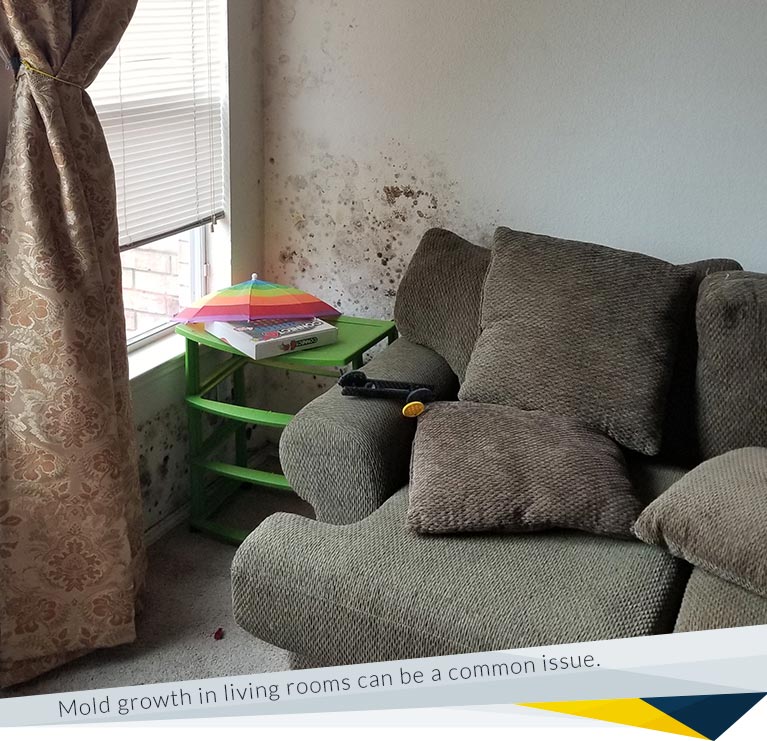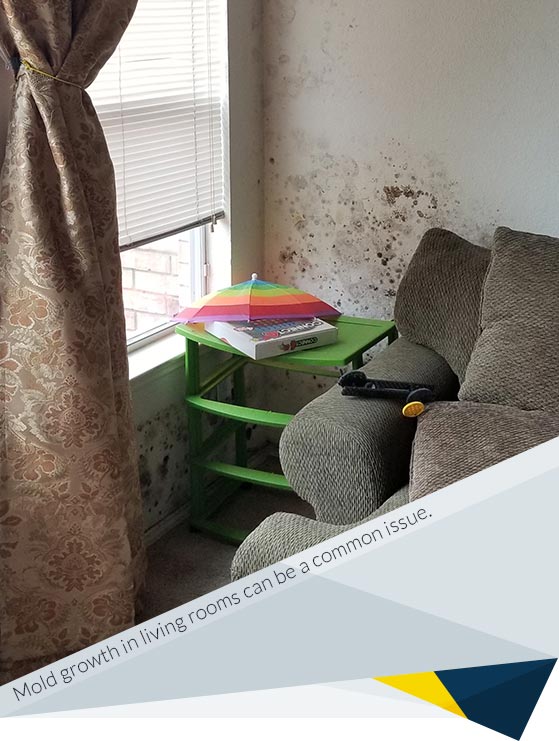
Mold are living organisms that are neither a part of the animal kingdom nor the plant kingdom. Mold, also sometimes referred to as mildew, are a classification in the fungi family or fungi kingdom. They reproduce by producing and scattering microscopic spores which act like seeds. Mold grows both indoors and outdoors, depending on the variety. Indoor mold can be problematic for humans because exposure to them can lead to an array of negative health consequences.
There are a number of toxic mold types that are found in indoor home environments. The three most common household mold strains are:

Mold spores are microscopic and can travel easily in air currents. Mold that grows in both indoor and outdoor environments can enter your home through doors and windows. It can also attach itself to the clothing of family members or to your pet's fur.
Once mold is inside your living room, like all other living organisms, mold requires moisture to grow and propagate. Mold grows best in humid climates and during rainy seasons. Sometimes leaks in the roof or plumbing leaks will provide moisture for mold growth. Something as simple as a spilled glass of water that is allowed to soak into a rug or carpet can provide enough moisture for mold propagation. That's why keeping your living room clean, dry, and well-ventilated is key to preventing mold growth.
There are a number of telltale signs of mold in your living room. If you detect mold, or even suspect mold growth, the time to act is now by contacting a mold remediation specialist who is an expert in living room mold removal. The longer mold is allowed to remain in your living environment, the greater the threat to your family's health.
Carpets and rugs can easily become contaminated with mold. Once moisture gets underneath them, there is usually insufficient ventilation for the area to dry out and mold can begin to grow and flourish. Look for spots and see if you detect any odors. Be sure to examine both sides of the carpet and padding.
You may have a closet adjacent to your living room with coats and odd clothing. Oftentimes, outdoor gear gets put away without properly drying out after a rain or snowstorm and mold can take over. Inspect each garment for any discoloration and feel for any unusual fluffiness or sliminess.
Do you detect any damp or musty odors, like that old book smell, anywhere in your living room? If so, your nose knows. Those odors are probably signs of what's called MVOC's, aka mold volatile organic compounds. These are caused by chemicals released as the mold grows. Time to call the mold remediation specialist.
If any family members have ongoing or intermittent flareups of allergy or asthma-type symptoms, that could be a sign that their bodies are reacting to mold exposure and they are suffering from the health risks of living with mold. Mold exposure can cause runny noses, itchy eyes, and coughing.
Mold loves damp smooth surfaces, like leather and vinyl. It also loves the nooks and crannies of upholstered fabrics. Look for any fuzzy growths or spotty discoloration.
Mold growth within wall materials or beneath paint will cause a warping or bubbling. It will usually be accompanied by some discoloration, especially black. If you suspect mold growth, the first task is to identify the source of moisture. The second thing to do is call in your local mold remediation expert. If you live in the Brooklyn area, FDP Mold Remediation is who you want to call.
Every day you stay or live in a room with mold, you are putting your health and the health of your family members at risk. There are serious health risks associated with prolonged mold exposure.
A 2017 review study, published in the "International Journal of Hygiene and Environmental Health" entitled "Medical diagnostics for indoor mold exposure", helped to establish mold exposure guidelines for "Association of the Scientific Medical Societies" in Europe regarding the health risks of living with mold. The guideline is used to inform physicians how to advise and treat patients who have been exposed to mold in their homes and other indoor environments.
The costs associated with hiring a mold remediation specialist in the Brooklyn area depend on certain factors, including:
It's important to hire a local company that you can depend on. FDP Mold Remediation offers an onsite mold inspection service for a flat fee of $149. If you hire them for mold removal, then the initial $149 fee is deducted from the final price of the subsequent work.
The best time to call a mold remediation specialist is today. Don't put your family's health at risk. The sooner you detect and find mold in your home, the safer your family will be and the easier it will be for FDP Mold Remediation to remove it.

